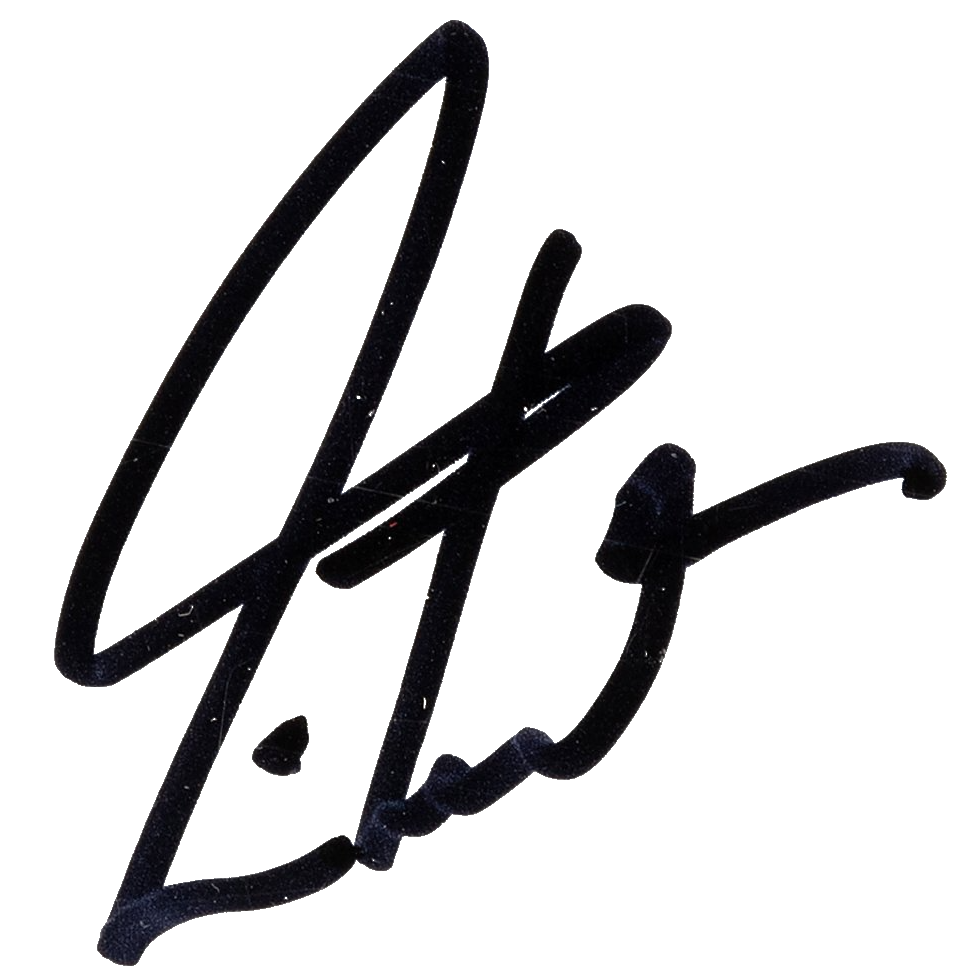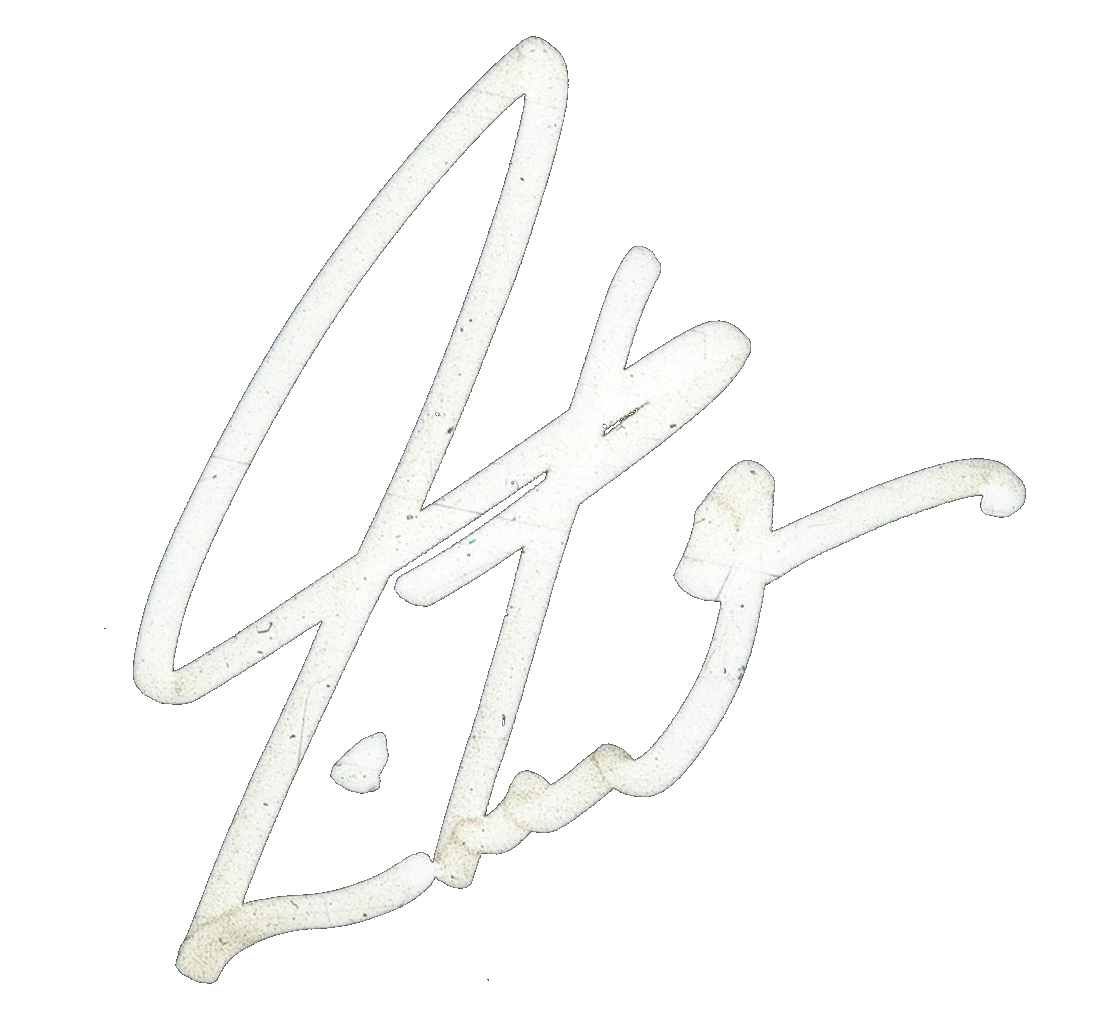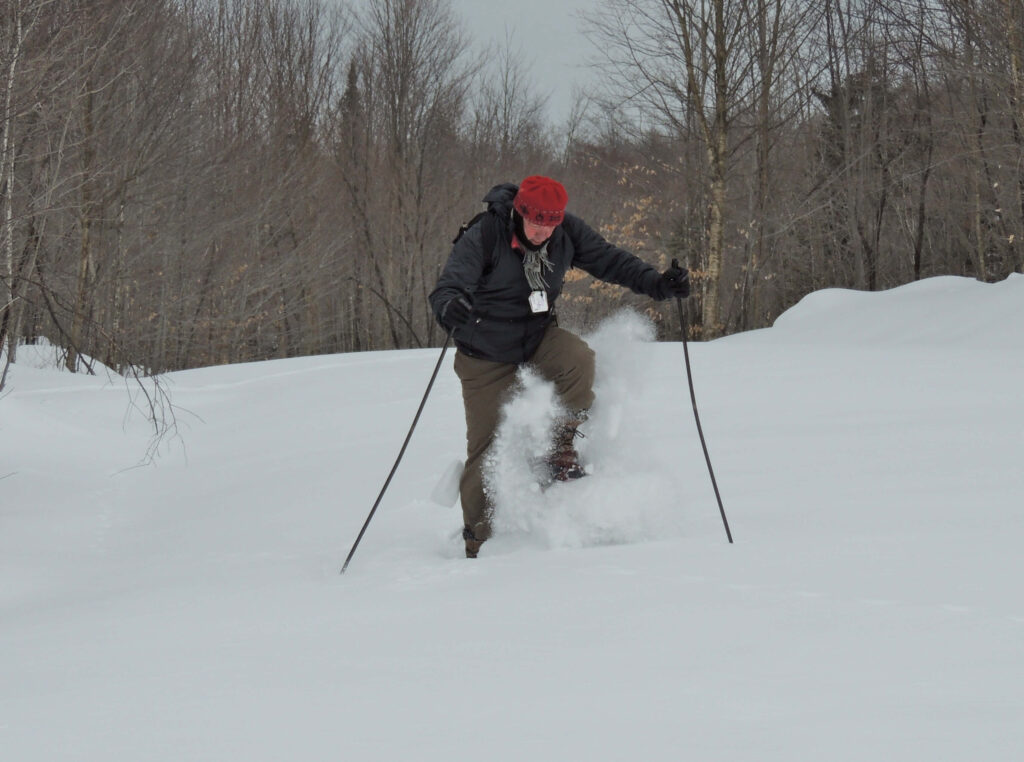
photo by Charles Voisin
The title is a West African saying, describing what in that part of the world is a cultural ambivalence toward life’s . . . vagaries. Some good days, some bad days. Into each life a little rain must fall. Ski trails may turn to ice. Every silver cloud has a dark lining. Not all days are Sundays.
Interesting that the “Sunday” metaphor seems to be fairly universal, not only in the West, but in many regions of Africa and Asia where Christian missionaries have been active. Despite choosing a different day of the week, the tradition is maintained among Jews and many Muslims—an ideal day of rest and ease, and sometimes prayer. I defer to Aldous Huxley’s father, who said a walk in the mountains was the equivalent of going to church. This reporter would maintain that the same equation applies to other pleasurable activities in nature, like the above display of devout snowshoeing.
That day, though, was a Sunday, in every sense. It was early February, in the Laurentian Mountains of Quebec—a day that was everything that season, in that place, ought to be. Over two feet of snow covered the ground and clotted on the trees, the sky was pearly gray in a light overcast (often a harbinger of snow, like the proverbial “white sky”), and the temperature was in the single digits Fahrenheit. Cold, but not bitter cold.
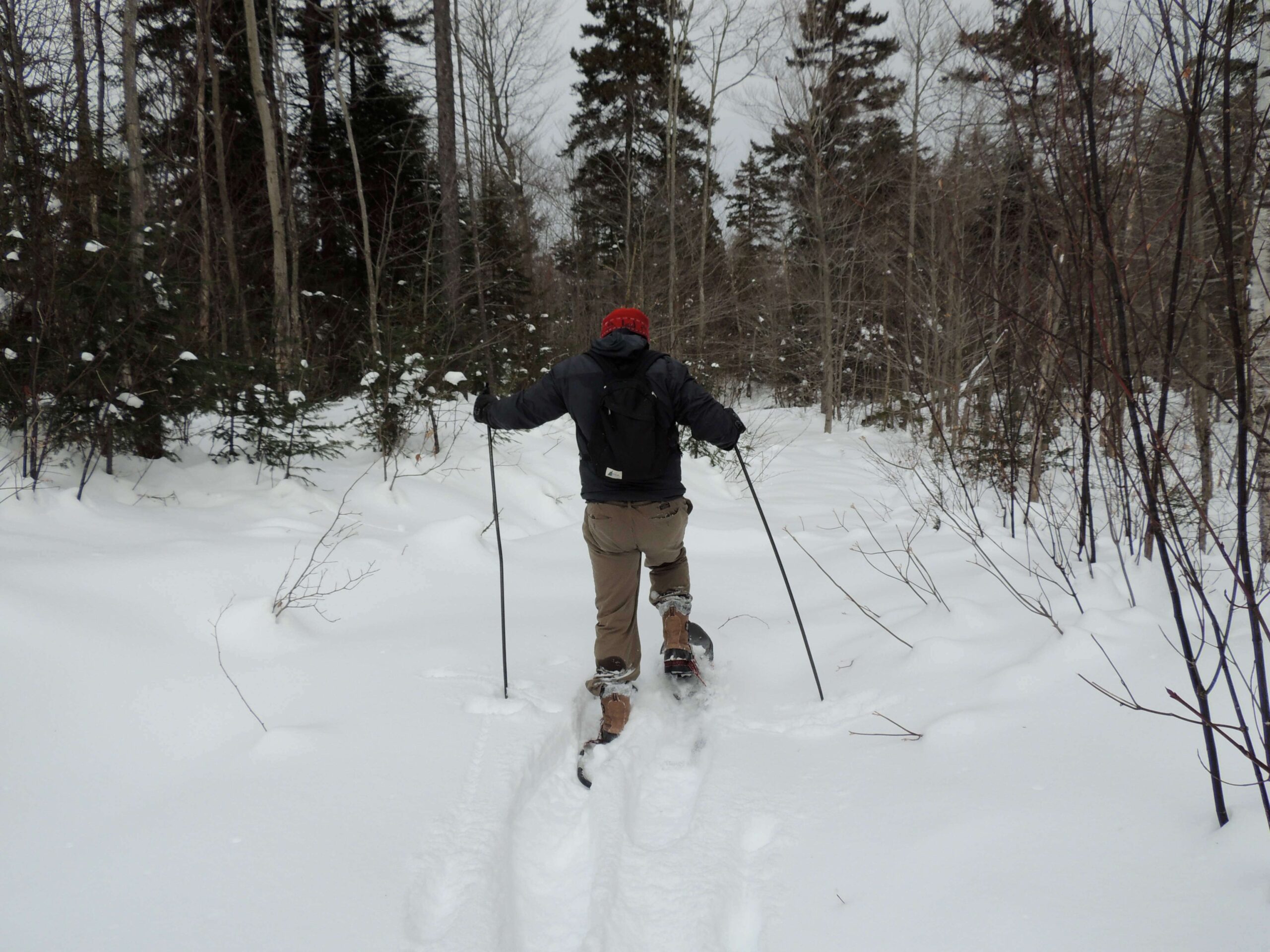
photo by Charles Voisin
Neighbor Charles (silent “s”) and I tramped happily into the backland across the road from our houses. We entered a vast territory of roadless, uninhabited third-growth forest, where a few old logging roads and survey lines made cleared passages. We could explore them almost limitlessly for miles to the east and south, away from the inhabited lakes.
We took turns breaking trail through deep powder, and talking about the trees around us, the animal tracks in the snow, and our lives. In our local woods, Charles and I are particularly fond of the hemlocks, les prûches, the largest, most majestic, and shapeliest of our trees, especially in winter. Often the hemlocks stand together in small groves, over a hundred feet tall, with trunks over a foot thick. Yet they are surrounded by the bare gray spindles of much younger hardwoods, or comparatively ragged-looking spruce and fir. Our area had been logged over twice, in the late nineteenth century and in the mid-twentieth, so the bush we explored was all third-growth—only the hemlocks seemed at all “venerable.”
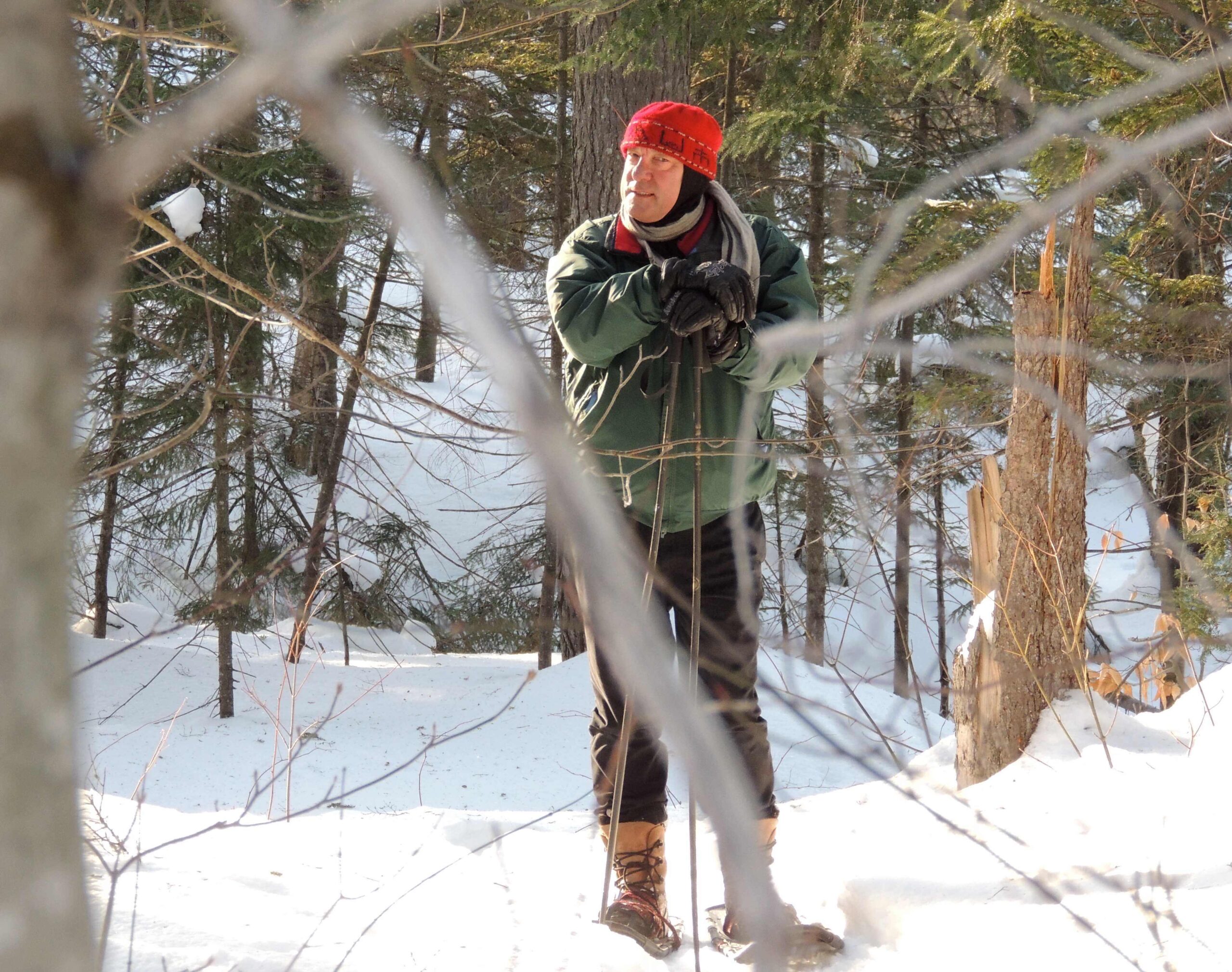
Photo by Charles Voisin
The once-mighty forests across Southern Quebec and Ontario had originally been dominated by lofty oaks and white pines, but after the first cut the oaks didn’t grow back (they could not compete against the faster-growing birches and poplars). Cedars and maples are among the other common trees that can grow to a good size. The tall white pines, the monarchs of the north, remain rare in our area—mostly on the small islands, for some reason. Perhaps that made them harder to cut and transport in the horsedrawn era, yet it should have been easy enough the second time around—the logging industry was well motorized by the 1950s.
I had been told the loggers spared the hemlock groves because they camped under them, but being efficient pillagers of the earth, you’d think they would have hacked them down before moving on. After all, every tree represented a few pieces of silver. In any case, for Charles and me, the presence of those old hemlocks is one of the sweeter mysteries of our woods.

And talking of the horsedrawn era, and mysteries, one day I was snowshoeing alone, far back in the woods on an old logging track, and noticed this unnaturally-symmetrical object about nine feet up in a yellow birch. Someone must have found it the previous summer or fall (I was sure it hadn’t been there last winter; I would have noticed it), and thrown it high into a tree for a “ringer.” However that hundred-year-old horseshoe arrived there, I can say it signified a good-luck omen for me that February—though similarly tarnished by the weight of years, hard weather, and loss.
If this year did not quite offer “The Best February Ever” I crowed about back in 2008 (mostly to do with the weather, which has its own vagaries, of course), it was still pretty great. I was able to spend the entire month there, and in the middle, welcomed Carrie and Olivia for a week. Four-and-a-half-year-old Olivia would finally experience her true Canadian half—winter!
(We had tried to bring her there the previous year, but to my disappointment, she was afflicted with the childhood cliché of ear infections, and couldn’t fly.)
So often when I am in Quebec in winter, I think of the evocative line by French-Canadian poet Gilles Vigneault: “Mon pays ce n’est pas un pays; c’est l’hiver.” My country is not a country, it is winter. The thought marries well to a line delivered by Canada’s then-Governor General, Romeo LeBlanc, when my bandmates and I—the Guys at Work—were awarded the Order of Canada, in 1996. Speaking of the qualities and experiences that unite all Canadians, regardless of culture or language, he said, “We all know what it’s like to be alone in the snow.”
If we Canadians know what it’s like to be alone in the snow, we also know what it’s like to be together in the snow. It was an extreme delight for me to introduce Olivia to a whole new world of quaint Canadian customs dans l’hiver.
It begins, of course, with taking half an hour to get dressed—putting on all the layers, the boots, the scarf, the mittens, the balaclava (Olivia loved to say that word), hat, and sunglasses.
Then to walk outside and feel the shock of the cold—even if only on the two inches of face left exposed, but also in the nostrils and lungs. Cold fresh air like that is definitely a mild narcotic—just as I once described my favorite drink as “February in Quebec.” Olivia climbed the snowbanks, slid down them, dived into the deep powder, rolled in it, swam in it, and finally, tasted it. She said, “I love snow!” My heart melted.
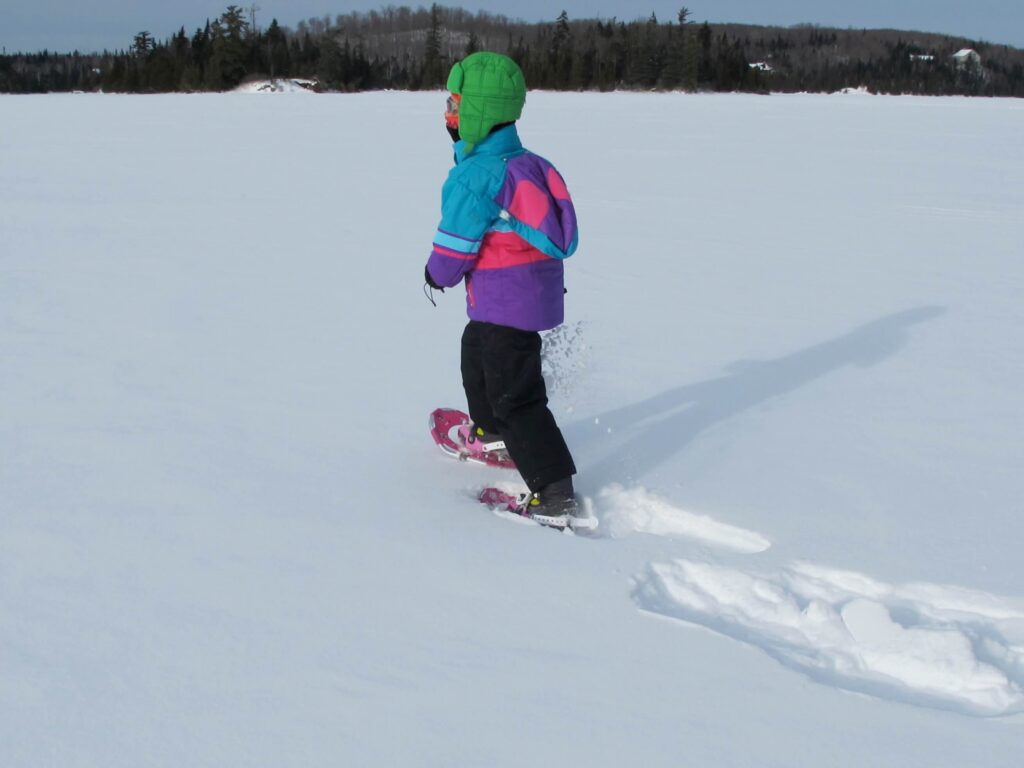
The next day I got Olivia strapped into her new pink snowshoes, and she took to it right away. (One great thing about that sport is its natural technique—if you can walk, you can snowshoe.) We took a lap around the house to get the hang of it, then climbed down the steep bank to the open whiteness of the lake. Several feet of snow lay over an equal thickness of ice, and Olivia was fascinated by the concept, stepping boldly out onto the immaculate surface.
It was my natural instinct to want to pave her way—to go ahead and pack down the trail for Olivia. I told her, “It will be easier if you follow in my tracks, and let me break trail.”
She said, “I want to break trail!” and marched off across the lake beside me.
Pointing to the line of trees on the far shore, perhaps a half mile distant, she said, “Let’s go all the way across.” I loved her spirit, but wanted to make sure this first time on snowshoes was positive—didn’t want her getting sore or tired. I turned us back halfway, knowing we still had that steep bank to climb. Sure enough, there was some slipping and falling, but no complaining. When we got to the top, I told her, “You are really good on snowshoes—very strong and very brave.”
She burst out with, “I am the Merida of snowshoes!” (Scottish princess from the Disney movie Brave, see.)
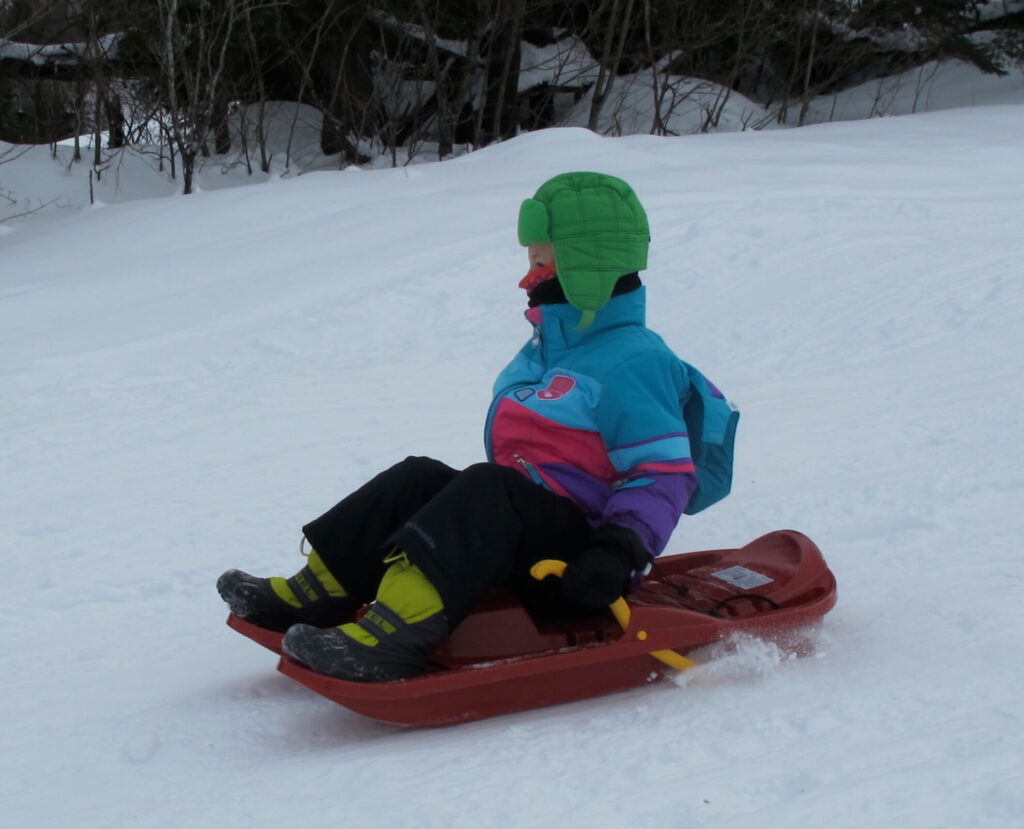
Another day we all went tobogganing and sledding at a small abandoned ski hill nearby. In my former life it was a great family place on weekends, with a T-bar lift and a small chalet serving hot chocolate and fries with gravy. I have many happy memories of winter afternoons there with my lost Selena in the ’80s, when she was eight or ten. Riding up the T-bar, she was so small that when the crossbar fitted behind her butt, as it should, it had to be behind my knees.
All of that was long gone, but the hillside remained clear for cross-country skiers and sledders. Olivia liked tobogganing, nestled between my knees as I steered us down the hill with my boots, but she especially loved piloting her own little red plastic sled. Like cross-country skiing, the thing about tobogganing is you don’t just ride down the hill—you have to climb up it, too. But Olivia was game, and we made many spectacular runs, together and separately.
After, we drove home, got out of all our wet clothes, and I taught her how to build a fire (she loved the word “kindling”). I made hot chocolate (the proper kind, with whole milk, chocolate syrup, whipped cream, and shavings of dark chocolate), while the fire flared up and snowflakes whirled outside the windows, bluing into evening. Olivia’s previous idea of snowstorms had been the little glass snowglobes her grandmother gave her every Christmas, and she said, “It’s like someone shook up the world!”
Indeed, dear daughter . . .
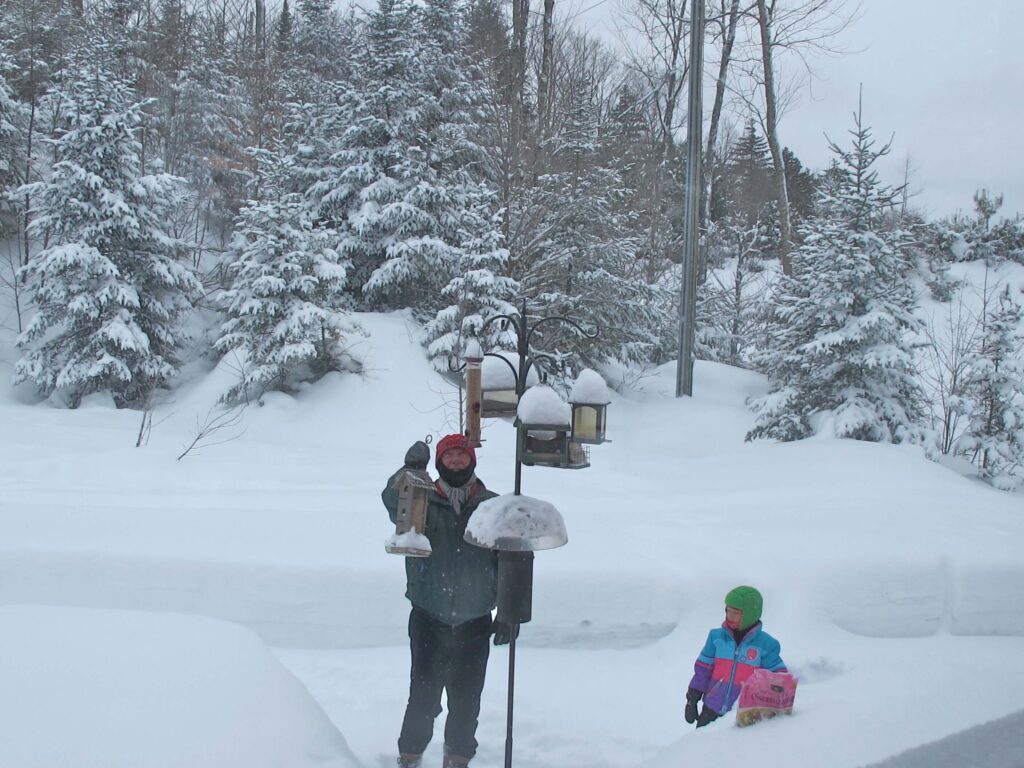
photo by Carrie Nuttall
One snowy afternoon Olivia and I bundled up and went out to fill the birdfeeders, “Bubba’s Seeds ’n’ Suet.” The blue jays clean out the mixed seeds almost daily—I call them the “crackheads” of the bird world. Mobs of them flock to the feeder, all edgy and screechy, nodding their blue crests and flapping their wings, to chase away all the friendly little chickadees. (Blue jays actually imitate the call of the red-tailed hawk, to make them seem scary—like punks imitating gangsters for status.) Twitchy and nervous, they sweep the seeds wastefully aside and onto the ground with their bills, to get at the choice ones they want. With their cheeks full, they flock off to hide seeds for future days. (I read once that jays can remember up to 10,000 hiding places.)
Blue jays are clever and attractive, all right, but their character is not very appealing to this bird-lover. It occurred to me that just as you might say you like people, but not all of them; the same is true of birds. Crows and blue jays, say, bullies and robbers, represent the bad kind of people, too. The chickadees are cheerful and social, innocent pacifists, and let themselves be shouldered out—but the woodpeckers don’t fear the jays, nor do the smaller nuthatches, white-and rose-breasted. They simply ignore them, and carry on feeding.
I noticed there were no redpolls around this year, or juncos—often the weather farther north dictates which birds are driven south to feed at Bubba’s.
One unusual visitor puzzled me, as it had once years ago, I eventually realized. It was the size of a finch or sparrow, dove-gray, black wings barred with white. I thought I knew all of the local species, but I just couldn’t think what this one was. I finally identified it as a female goldfinch in her plain winter plumage—the one variation that is seldom illustrated in the bird books. In the following days there were five or six of them, including a few males, which are more yellowish, and thus more identifiable.
To my surprise, they didn’t even touch their summer favorite, the Niger seeds (let’s pronounce it like the country in French, “nee-jzhair”), but went for the fattier sunflower seeds. Similarly, some seed-eating birds eat insects only during breeding season—for the protein. Vegans become carnivores during that critical time. (Like pregnant human females you hear about, tearing up their PETA cards and diving into burgers.)
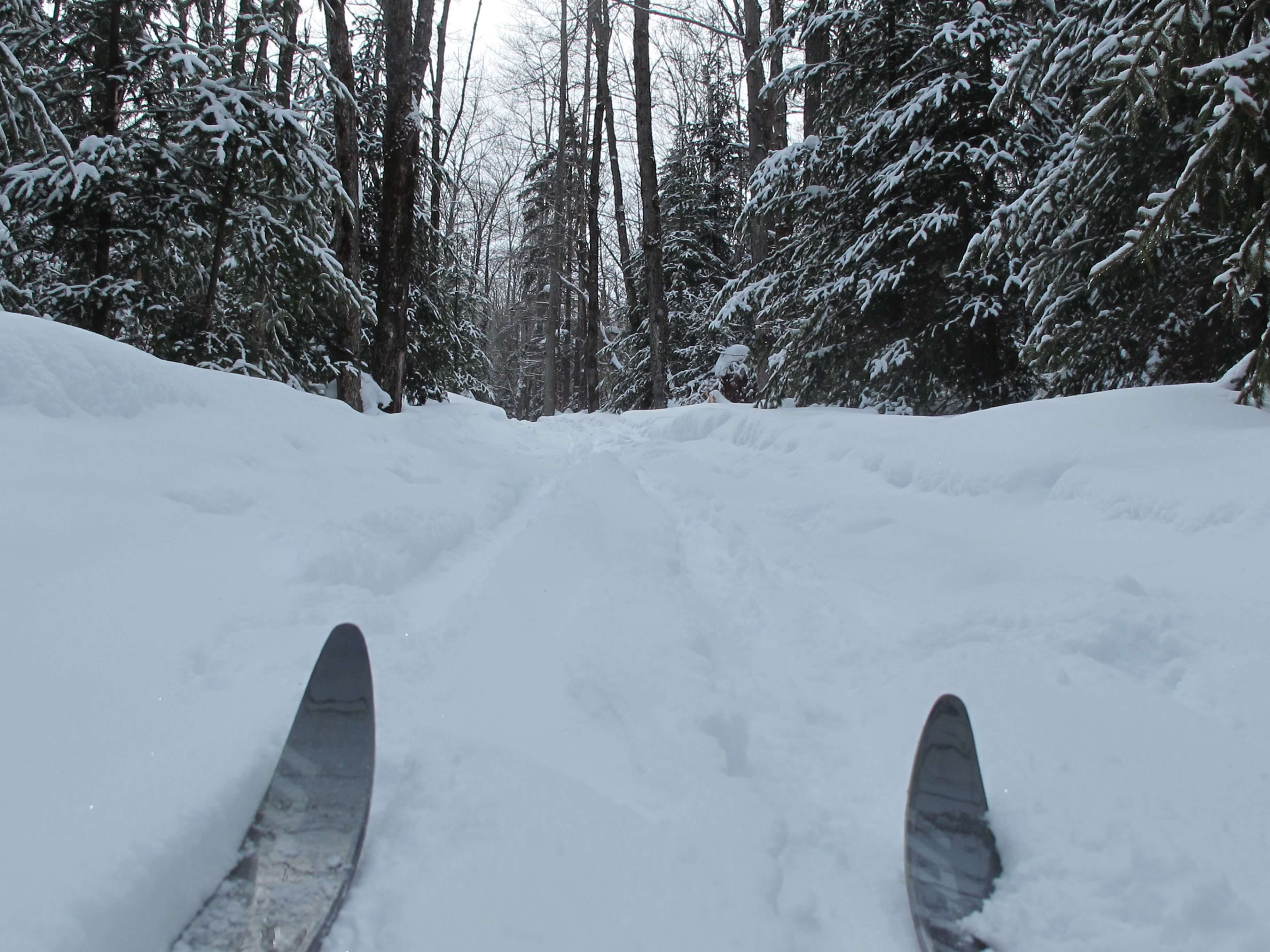
Before and after the family week, I had ten days on my own for reading, writing, cross-country skiing, and snowshoeing. Mornings and evenings were spent with books and words, quiet and studious (two favorites of the month, Sacré Bleu by Christopher Moore, and TransAtlantic, by Colum McCann), while afternoons lured me out into the snowy woods. There was only one day I didn’t go out—in freezing rain, a useless kind of weather—and one day I shouldn’t have gone out, in the aftermath of that ice storm. Later I was writing about that day to my little email circle, the “Breakfast Club for Cuties”—Brutus in Calgary, brother Danny in Vancouver, and Craiggie in South Pasadena—and immediately thought of that West African quote for the title of my message to them, “Not All Days Are Sundays.”
The icestorm struck on a Friday, when the temperature rose a few degrees above freezing. Typically freezing rain or ice pellets are caused by a warm air mass flowing in, so the precipitation falls as rain, then either freezes on the way down, or when it reaches the ground. At its most extreme, an icestorm brings down trees like matchsticks, and electrical pylons are crumpled like so much tinfoil.
This storm wasn’t that severe, but driving or even walking on wet ice is near impossible. I went out to fill the birdfeeders (cursing the crackhead blue jays), and could hardly keep my feet under me—had to hang onto the front porch pillars to make it out to the softer snow.
That night, the temperature shot down into the deep freeze again, and the briefly softened snow hardened into a solid crust. That was fine for snowshoeing, even sometimes quite good—not sinking in so much—but it is not suitable for cross-country skiing. In order to move forward, it is necessary for the skis to grip the snow briefly, with the aid of temperature-sensitive waxes. (Cross-country ski waxes range from various purples and reds for warm temperatures through blue and green for colder, with many variations and hybrids in between, each with specific ranges for air temperature and freshness of the snow. It’s a kind of alchemy.)
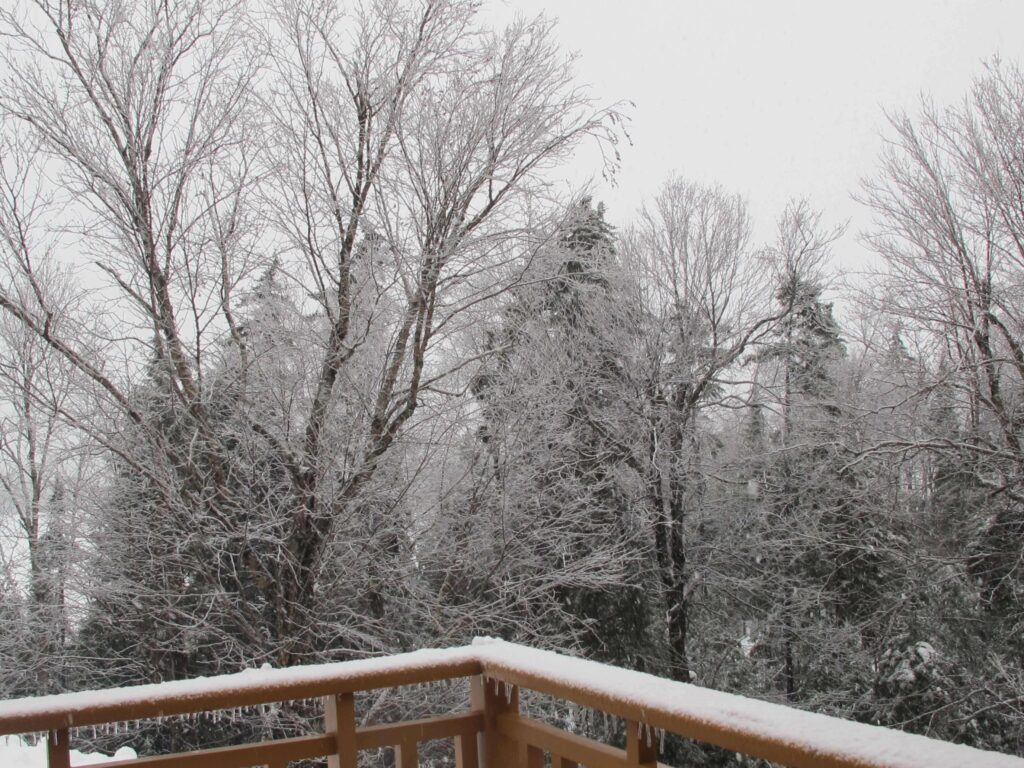
The following Monday promised at least a dusting of new snow, so I decided to try an old favorite ski trail—a ten-kilometer loop with rolling terrain to change up the rhythm, and some pleasant variations in the passing woods. In some areas bare gray branches stood against the open sky, in others shadowy evergreens arched over me, like skiing through a tunnel. Thirty years before, it had been the first proper trail I ever skied, and I had done it dozens of times since, so I was looking forward to an enjoyable “rendezvous.”
It started out all right, with a flat stretch along the old railway alignment, then up a long, steep climb (the same old ski hill where I had tobogganed with Carrie and Olivia). Then I came to the first gentle, curving descent, and it swept me downhill faster than I liked, skis clattering over the crusty surface. I couldn’t gain any “bite” to steer, to make a snowplow of my skis and push against it for control, and the light new snow had not penetrated the trees enough to help.
A still steeper section swooped down and to the left, and I couldn’t make the turn—I had to bail out, by sitting down. (Trailcraft: I have learned it is better to choose when you’re going to fall, rather than hold on a little too long and take a “headlong flight”—quite possibly into a tree.) As I slid along the icy crust, it pushed up my jacket and underlayers, and scraped the skin raw above my beltline. That unyielding surface also offered no purchase for the wax, which needs crystals to grip and push against, then release into the glide part of the motion. Again and again, a slight misstep or icy bump made one ski slide away under me, triggering a sudden animal bellow as I scrambled to stay upright. The freezing rain had also brought down twigs, dry leaves, and needles, to litter the trail and drag on one ski or the other, so the amount of slip or grip was unpredictable. Soon those sudden bellows of fear were laced with shouted profanities of rage, and I was becoming . . . “discouraged” . . .
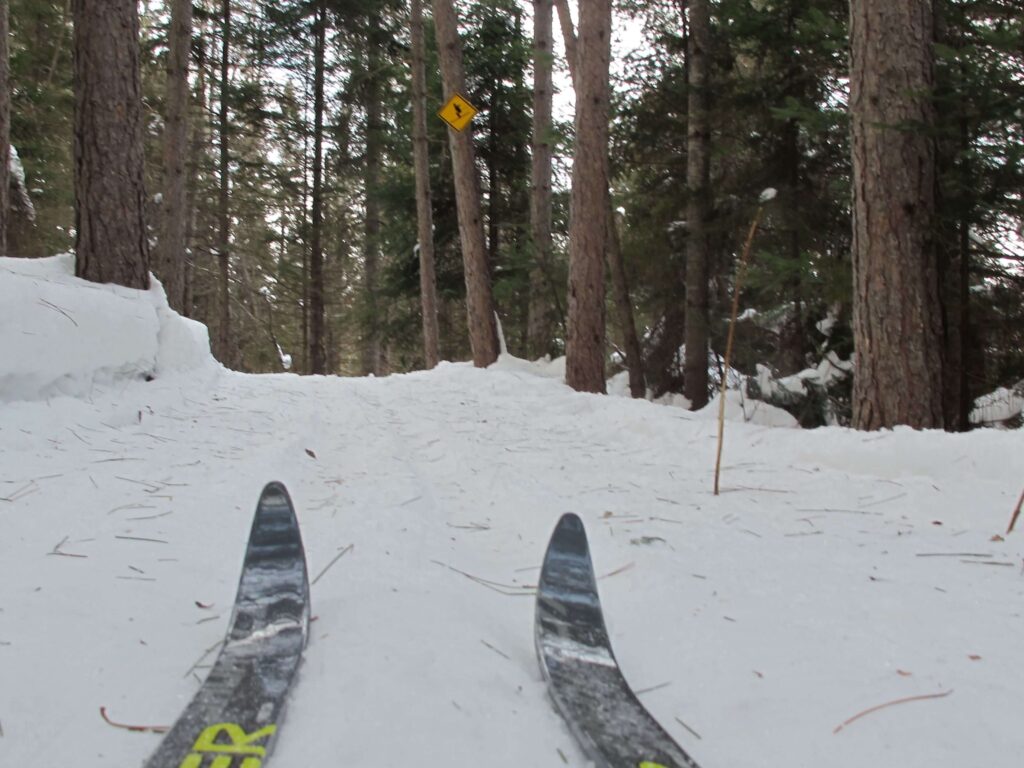
The yellow sign above this crusty, littered, and wretched trail warns of a steep downhill approaching. That day, it meant I would have to stop, take off my skis, and walk down the hill until the trail was navigable again. Tracks in the snow told me that the one skier who preceded me that day had done that, and I decided to follow that sensible example. Steep climbs required the same desperate measure, because there was nothing for a herringboned ski to edge itself against—it just slipped back with a sandpaper rasp, and threatened to upset me in a particularly unpleasant, spread-eagled way. More animal bellows and curses rang through the silent forest—with no one to hear. Other than that single set of tracks—boot tracks—I didn’t see one other skier that day, and no wonder. In thirty years of cross-country skiing, it was the worst conditions I had ever known. More fool me—I had dared to hope.
There was no turning around because, unusually, that particular trail was a one-way arrangement. Its steep, narrow slopes could not be safely climbed and descended by two skiers at the same time. The downhill skier would be moving too fast, with no view ahead, and the uphill skier had nowhere to get out of the way, so there was a risk of painful collisions. Instead, I chose a shorter loop back toward my trailhead. Still, even that was a difficult, “dynamic” trail, and I had to take off my skis and walk for at least ten climbs and descents. I had never had to walk so much—nearly as far as I skied—and it was a long, hard, unrewarding three hours before I made it back to my car.
Brother Danny offered me a suitable quote, from Shakespeare’s Richard II.
These high wild hills and rough uneven ways
Draw out our miles and make them wearisome
Weary indeed, and sore all over, I hobbled around the house at my evening chores. After sitting for a while, I rose stiffly to my feet with a groan. I chuckled at how wrecked I felt—amused now, because it was over, and I had endured it.
I decided to wait for new snow on the ski trails, and the next afternoon went snowshoeing instead—a much more stable mode of travel for those conditions.
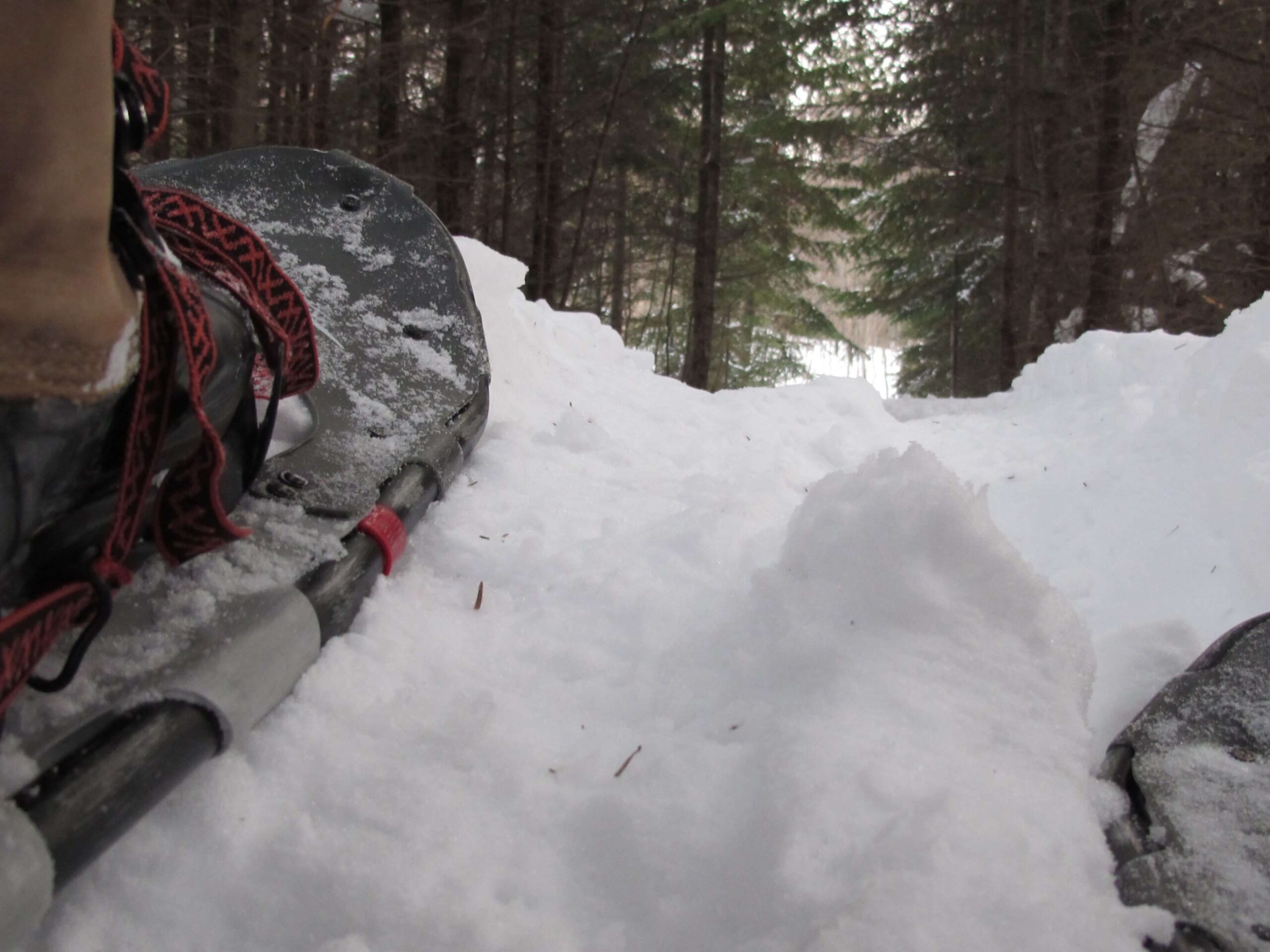
Later that day and overnight, a few inches of new snow gladdened my heart, and I decided to try the “skinny sticks” again. I knew one trailhead that would give me several options—a long, more-or-less flat cruise, or various loops with more challenging terrain. That way I could make a decision after I saw how things were. Live and learn.
As I set out—again following only one other skier—the snow was soft, pliant, and grippy under me, and I fell into the easy rhythm of kick-and-glide. Where the old railway alignment tended slightly downhill, I was able to get into the double-poling stride (or “kick double pole,” technically), perhaps the most graceful of cross-country cadences. You reach forward with both poles and plant them, push back as you kick with one ski, then glide a fair distance as you bring the poles forward again, then push and kick with the other ski. There are only a few areas where I can ever get that groove going, and only if the conditions are right.
Without thinking much about it, a plan seemed to “crystallize,” and I found myself turning off to take the long way. That trail represented my “benchmark” loop, usually about a three-hour circuit, with every kind of terrain in pleasantly varying rhythms.
About one third into it, I realized that not only had I not fallen, I hadn’t once lost control. No animal bellows or flights of roared profanity disturbed the peaceful winter forest. In fact, I realized, I was making very good time. Over the years I had made notes of my best times on some of the local trails, and that day I happened to notice I had started at 12:50, so I decided to see what sort of time I could post. Not racing, but skiing steadily, without pause, I climbed the uphill pitches, strode smoothly along the flats, and glided downhill with perfect control against that yielding cushion of snow.
Back home, showered and changed and feet up by the fire, I saw that some years ago I had recorded two hours and twenty minutes, and in 2011 cut that to two hours seventeen minutes, in what I described as “very good conditions—light snow, minus 4 degrees.” That day’s time was two hours and thirty minutes—close enough to my “personal best,” without half trying, and I felt great after.
How easy it is to exercise hard for two or three hours every day when it’s something you enjoy—not stuck in a gym pumping grimly at some machine that merely imitates the actual sport. (Without the scenery, or the air.) That was why I liked starting my tour preparations that way—using February as the launching pad for the spring’s fitness programs and rehearsals. No better, or more enjoyable, way to get fit.

The following day I returned to the trail that had so brutalized me on Monday. It was payback time. Even more new snow had fallen overnight, making conditions truly ideal, and that day I even dared to take on the “Black Diamond” sectors of the trail, which I usually took a longer loop to avoid. The above sign, just before that stretch, did not refer to this indomitable enthusiast. I am too gangly and graceless to actually be anything like “expert” at skiing, and as with other endurance sports like bicycling and swimming, it is just that I can do it for a long time. The photo shows that once again only one set of tracks preceded me on the trail that day, and that the new snow lay deep and powdery—easy to push against for steering and braking.
In the distance, the trail crests and then descends sharply out of view, the first of a series of steep, curving descents, twisting narrowly left and right between the trees on either side. I had always thought of that section as “The Chutes,” and with something more than respect. Call it fear. It was like a luge or snowboard run, swooping downhill with concave banks on either side, and over the years I had fallen there many and many a time—usually bailing out intentionally, when I was going too fast and realized I could no longer steer or stop.
On that first crest, I paused and took a deep breath, then let gravity sweep me downhill, skis edged out in a wide, triangular “piece of pie” (as the ski instructors teach kids) against the loose snow. Hallelujah—I was steering! I was slowing down when I wanted to!
However, the deadliest part of the Chutes was the end—hurtling downhill on the steepest pitch yet, then facing a sharp left turn. (What is wrong with the people who designed that trail?) I have almost never made that turn, and this day was no exception—gathering speed, feeling the edge of control approaching, and seeing that sharp turn looming ahead, I leaned back and sat down. I went tumbling to a halt in a jumble of limbs, skis, and poles, but unhurt. It was the only time on the entire ten-kilometer loop where I had to bail out that day, and I was okay with that.
I was more than okay—I was ecstatic.
Not for the first or last time that February, I repeated my friend Mendelson Joe’s mantra, “Every day is Thanksgiving day.”
Perhaps not every day—but certainly all Sundays!

This photo was taken at the end of that three-hour ski, in flurries of snow at about fifteen degrees below freezing. My sweat had soaked the balaclava, then leaked out to freeze in the cold air and form the “sweat-sicles” across my brow.
The next day was colder still, below my “safety threshold” for skiing alone. The problem wasn’t the actual skiing, because that activity creates its own warmth—but for that reason you can’t dress heavily enough for standing still, if necessary. Such bitter cold was only deadly for not skiing—like after an injury or equipment problem. You wouldn’t last long out there.
That Friday was my last day in Quebec, before flying back to the very different winter of Southern California (see “Winter Latitudes”). Of course I was determined to go out into the winter woods one last time—but on snowshoes instead. More stable, and almost no chance of a bad fall leaving you stranded.
Over the weeks I had tramped out a decent network of snowshoe trails, sometimes with Charles (silent “s”), and once the two of us with another Voisin, Robert (silent “t”). The packed-down tracks made for easier walking, even in fresh snow, so every time out I had pushed back a little farther into the trackless woods, following old logging roads or survey lines. I was able to explore areas I hadn’t visited for years, or even ever.
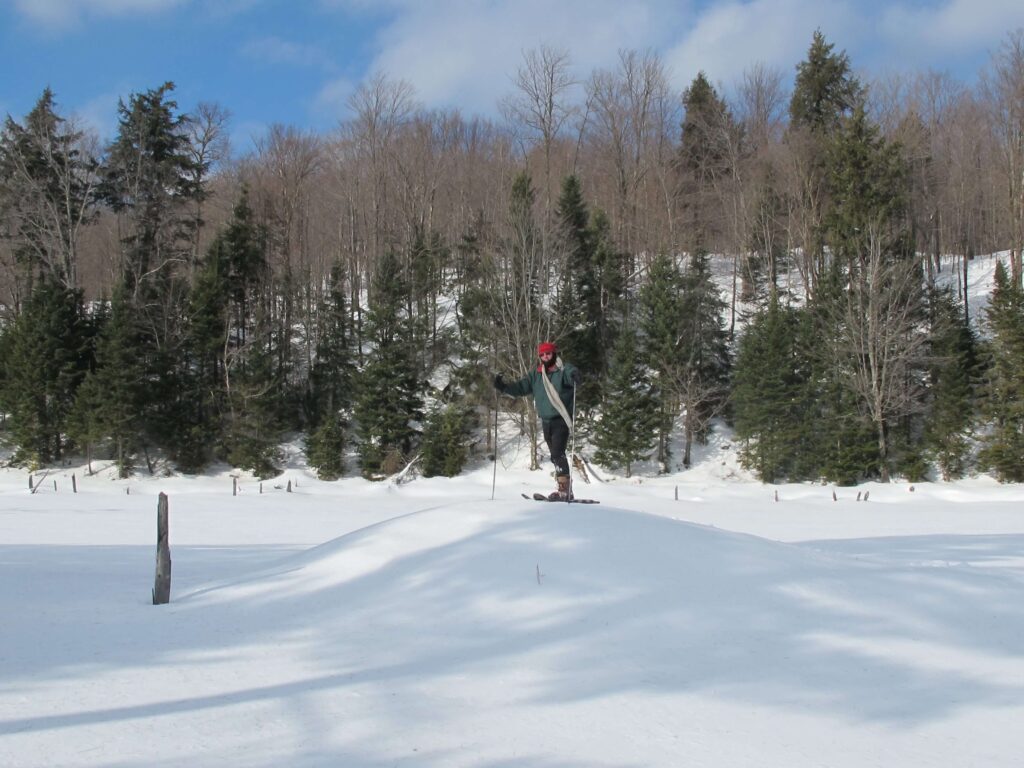
Photo by Robert Voisin
Far back in those deep woods was where the bigger animals took refuge through the winter, and I was pleased to see where a moose had been resting. The number and pattern of tracks showed that it had foraged and “nested” in the shelter of a bank of conifers—for a few days, it appeared, but not since the last snowfall. Its steps were marked by plate-sized holes in the snow, sometimes sinking deep enough to show the rounded depression of its body.
I was also happy to see some wolf tracks—a sure sign that that our wilderness endured.
Keeping an eye on the time, in that season of brief daylight, I turned around after an hour-and-a-half. The return journey was easy, over an increasingly well-tracked trail. I felt strong and fit—felt it in every muscle and joint—and was grateful for another wonderful season in the snow, and the sweat-sicle on my sunglasses . . .
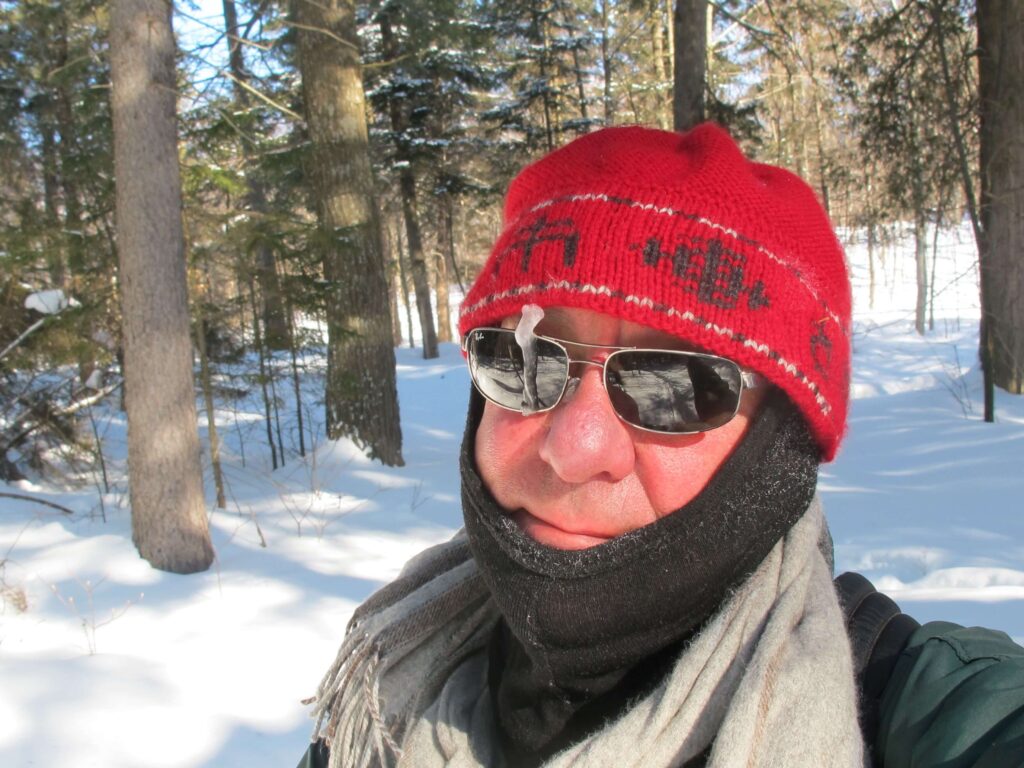
Not all days are Sundays, and not all Februarys are perfect. Much as I might resist having to modulate into a sad minor key, it is a part of our music—a part of our world—like it or not. As it is described so enduringly in the movie Down By Law, “It’s a sad and beautiful world.”
Smack in the middle of the month, a dear friend—a brother—was felled by a heart attack, just after his sixty-first birthday. My age. Steven was the elder brother of my late wife, Jackie. His twin brother, Keith, had looked after my Quebec homes for almost twenty years. We had been friends since our teens, back in St. Catharines, Ontario, when Keith and Steve worked at the local record store, and I was a struggling musician. Naturally, a struggling musician was going to hang around the record store (in those days, anyway!). At the time I joined Rush, in 1974, I was living in a farmhouse with Steve, Keith, and Wayne “the Bear” Lawryk.
In later years, Steven and I shared the worst times in our lives—in England after Selena’s death, looking after Jackie through her decline (her surrender) in London, Toronto, and Barbados. When I was at my lowest, Steven was my rock. After the wrench of Jackie’s passing, Steven met me on my Ghost Rider travels to help “kill Christmas” (the worst time of year when your family is shattered)—one year in Belize, with his wife Shelly, the next year pounding through Baja in his father-in-law’s Hummer. A few years later Steven lost his teenage son, Kyle, to stupid cancer, and I was able to be there for him. (The “walking wounded,” we called ourselves.) He was a good man, a good friend, and a good brother—I felt his loss keenly. His brother Keith was devastated. They had talked on the phone every day, and now there was a big hole in Keith’s life—“Like half of me has died,” he said.
At least I was glad to be around for Keith for a little while. All too experienced in the ways of grief and loss, I am not uncomfortable in the face of it, as those who have never known death up close can sometimes be. When my girls had flown back to California, I invited Keith over for dinner. He said he wasn’t feeling very hungry, and I understood, but when he dug into Chef Bubba’s penne rigate bolognese with Reggiano, he ate it all up. I sent him home with a container of leftovers for another good meal.
Sometimes there’s nothing more you can do for someone than cook for them—and the bonus of a little company is good, too. Of course there was nothing I could really do or say—there never is—just feed Keith a few more dinners, take him on the “Steven Memorial Snowshoe Hike,” and encourage him to share the good memories, that he might eventually learn to smile at them.

February 4, 1953, February 15, 2014
Photo by Shelly Bade
The Quebec woods in winter forever remind me of the friend who introduced me to cross-country skiing, over thirty years ago. Robbie Whelan was the assistant engineer at nearby Le Studio, which hosted an amazing variety of artists during the late ’70s and ’80s—Tina Turner, Wilson Pickett, Cat Stevens, David Bowie, the Police, Ritchie Blackmore, Keith Richards, Asia, and many more. In those years, the Guys at Work and I recorded at Le Studio many times, and became good friends with all of the staff, perhaps especially Robbie. He was an enthusiastic member of the recording team, fully into the music and the technical side of it, and was equally fired-up in our late-night volleyball games.
I remember
How we talked and drank into the misty dawn
I hear the voices
We ran by the water on the wet summer lawn
I see the footprints
I remember
(“Afterimage,” 1983)
In the spring of 1983 Robbie was killed in a car accident right near the studio, while the band was touring in Europe. It was the first “unnatural” death I had ever experienced—unlike the more-or-less timely passing of grandparents and elderly relatives, this was someone young, a friend. Now I consider the thirty years of my life before that as “Life Before Death”—because from then on my outlook was necessarily darker, especially as more and more deaths piled up around me.
The song I wrote about Robbie, “Afterimage,” has enduring resonance for me—true again and again, death after death. Another specific memory of Robbie in that song was him leading me down “The Chutes” for the first time. As I waited at the crest, not knowing what was ahead of me, I heard his whoops of fear and excitement ahead.
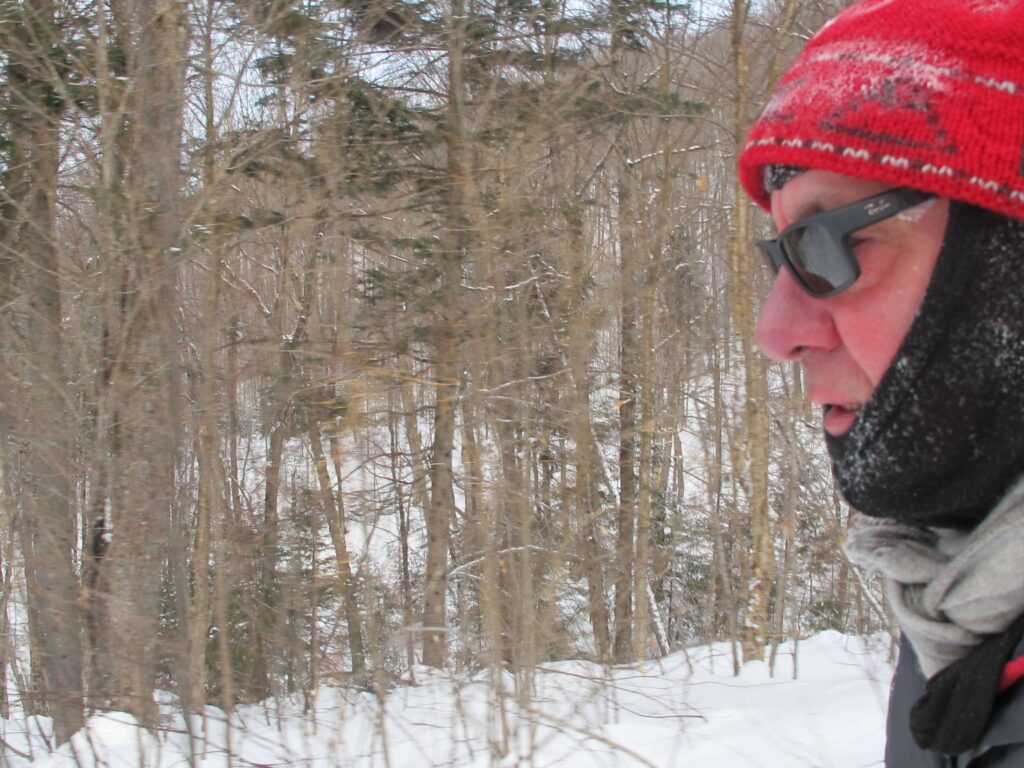
I remember
The shouts of joy, skiing fast through the woods
I hear the echoes
I learned your love for life,
I feel the way that you would
I feel your presence
I remember
And the opening lines, which came back to me when I was asked what to put on the “souvenir card” (ouch) for Selena’s funeral.
Suddenly
You were gone
From all the lives
You left your mark upon
Those lines had been true a dozen times since, and were true again with Steven.
When I was young, caught up in the solipsistic angst and insecurities of my teens and twenties, I truly believed life must get easier as you got older. Surely it must smooth out into some kind of plane, or groove, or even a rut. But of course I learned the opposite is true—the longer you last, life will just break your heart again and again.
All I know is that we really have no choice but to keep on breaking trail. Or, if we are fortunate, to follow in the tracks of those who have gone before, or of the young.
For now, at least, they remain immortal . . .

